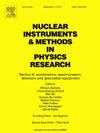新型二氧化碳基气体混合物的ATLAS RPC探测器和1级介子桶触发器的性能
IF 1.5
3区 物理与天体物理
Q3 INSTRUMENTS & INSTRUMENTATION
Nuclear Instruments & Methods in Physics Research Section A-accelerators Spectrometers Detectors and Associated Equipment
Pub Date : 2025-04-10
DOI:10.1016/j.nima.2025.170482
引用次数: 0
摘要
在ATLAS实验中,利用电阻板室(RPCs)在桶区触发μ子。目前的RPC探测器使用含有C2H2F4和SF6的氟利昂气体混合物,这两种气体都具有很高的全球变暖潜力。为了减少对环境的影响和运营成本,探索可替代的环保气体混合物至关重要。2023年8月,质子-质子数据采集完成后,ATLAS协作团队将标准气体混合物(94.7% C2H2F4, 5.0% i-C4H10, 0.3% SF6)替换为添加了二氧化碳的新混合物:64% C2H2F4, 30% CO2, 5.0% i-C4H10, 1% SF6。本文介绍了新型混合物的RPC探测器的性能,重点介绍了探测器电流密度、簇大小和一级介子桶触发系统的效率。本文章由计算机程序翻译,如有差异,请以英文原文为准。
Performance of the ATLAS RPC detector and Level-1 muon barrel trigger with a new CO2-based gas mixture
Resistive Plate Chambers (RPCs) are used in the ATLAS experiment for trigger on muons in the barrel region. The current RPC detectors operate with a Freon-based gas mixture containing and , both of which have a high global warming potential. To reduce environmental impact and operating costs, it is essential to explore alternative, environmentally friendly gas mixtures. In August 2023, after the completion of proton–proton data-taking, the ATLAS collaboration replaced the standard gas mixture (94.7% , 5.0% , 0.3% ) with a new mixture with added: 64% , 30% , 5.0% , 1% . This paper presents the performance of the RPC detector with the new mixture, focusing on detector current density, cluster size, and the efficiency of the Level-1 muon barrel trigger system.
求助全文
通过发布文献求助,成功后即可免费获取论文全文。
去求助
来源期刊
CiteScore
3.20
自引率
21.40%
发文量
787
审稿时长
1 months
期刊介绍:
Section A of Nuclear Instruments and Methods in Physics Research publishes papers on design, manufacturing and performance of scientific instruments with an emphasis on large scale facilities. This includes the development of particle accelerators, ion sources, beam transport systems and target arrangements as well as the use of secondary phenomena such as synchrotron radiation and free electron lasers. It also includes all types of instrumentation for the detection and spectrometry of radiations from high energy processes and nuclear decays, as well as instrumentation for experiments at nuclear reactors. Specialized electronics for nuclear and other types of spectrometry as well as computerization of measurements and control systems in this area also find their place in the A section.
Theoretical as well as experimental papers are accepted.

 求助内容:
求助内容: 应助结果提醒方式:
应助结果提醒方式:


